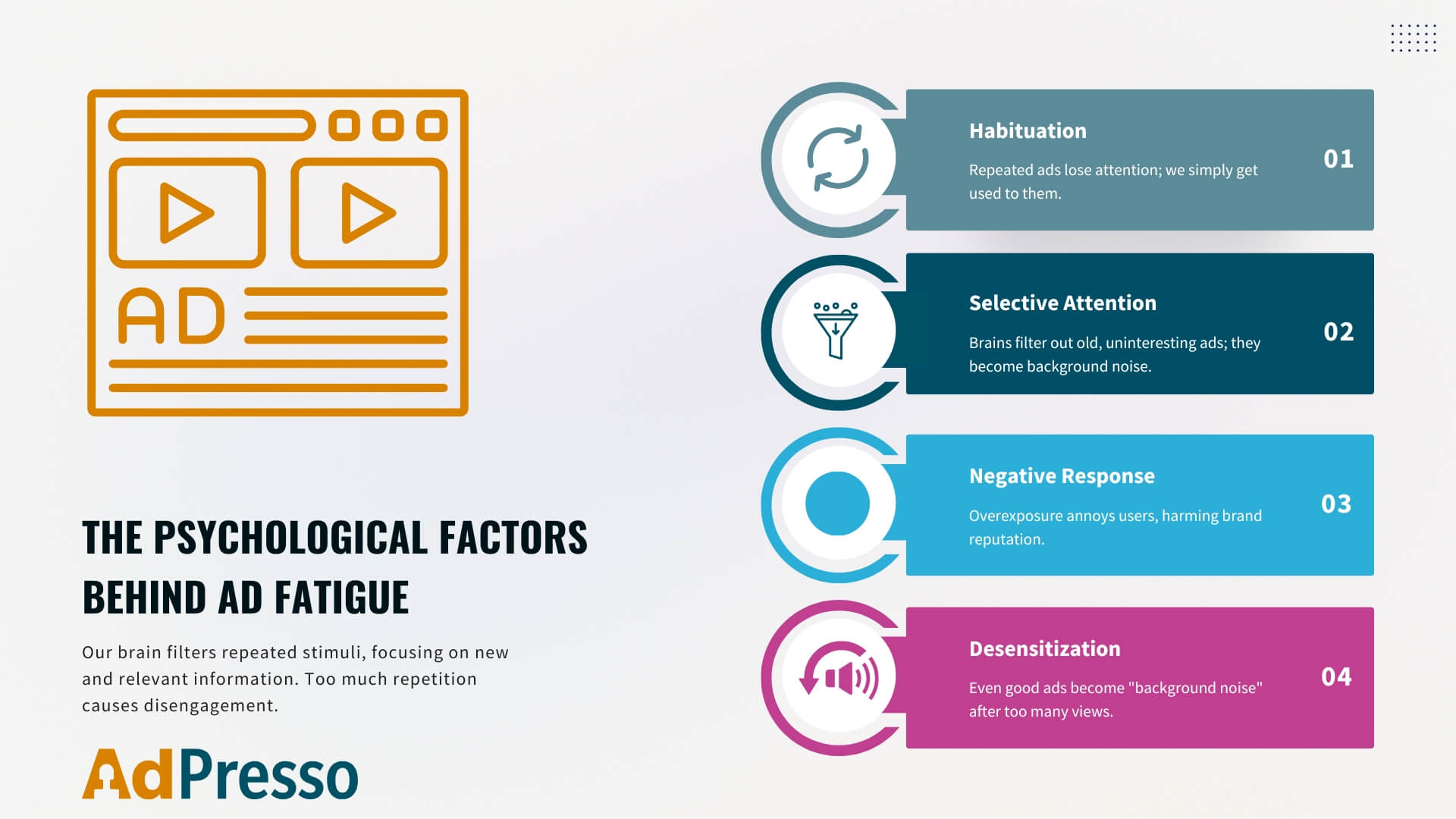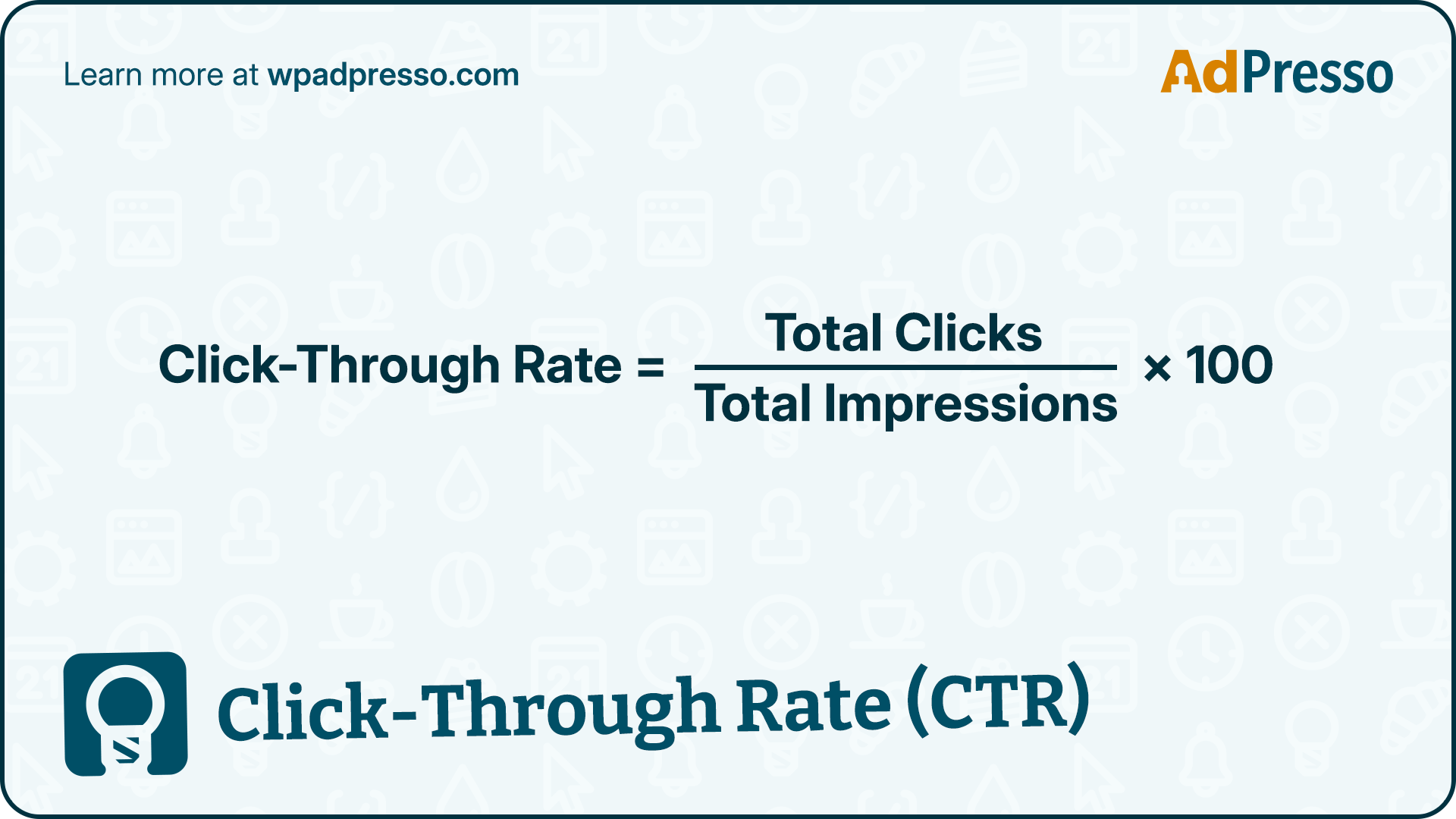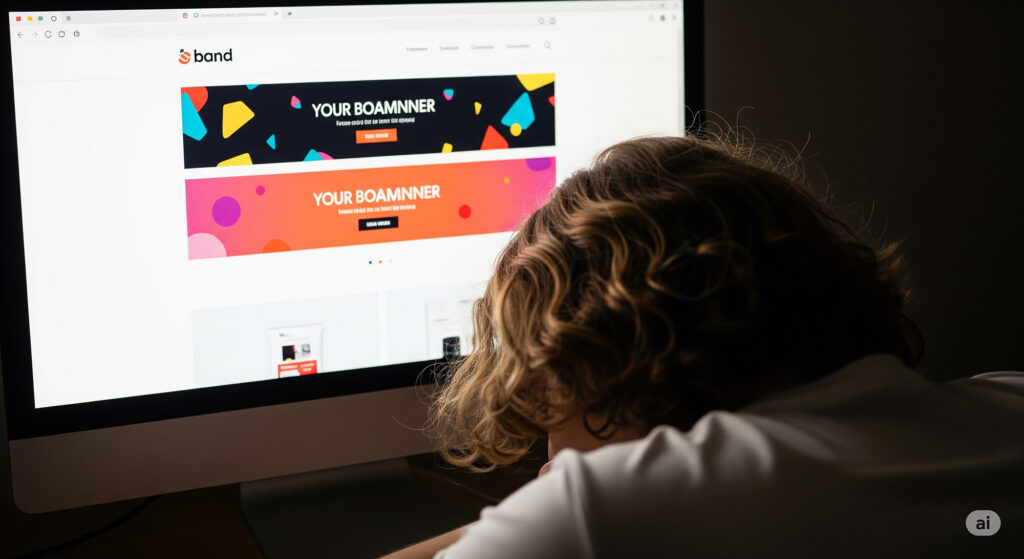In the increasingly saturated landscape of online marketing, capturing and retaining audience attention has become more challenging than ever. Brands and publishers constantly strive to deliver impactful messages, yet there's a subtle but powerful phenomenon that can silently undermine even the most meticulously planned campaigns: ad fatigue. This often-overlooked issue can transform successful, high-performing ads into ignored or even irritating nuisances, leading to wasted ad spend and diminished brand perception.
This guide digges into the core concept of ad fatigue, exploring its psychological underpinnings and the tangible impact it has on marketing performance. I will equip you with the knowledge to recognize its warning signs, understand its triggers, and, most importantly, provide actionable strategies to prevent and overcome it, ensuring your digital campaigns remain fresh, engaging, and highly effective.
Ad fatigue, sometimes referred to as advertisement fatigue or creative fatigue, describes the decline in effectiveness and engagement that occurs when an audience sees the same ad—or even very similar creatives—too many times. Overexposure leads consumers to ignore, resent, or become indifferent to recurring messages.
While early campaign results may be strong, as impressions mount, click-through rates (CTR), conversions, and engagement typically erode, while costs per action (CPA) simultaneously rise. Ad fatigue can affect any digital medium, including social, display, and video campaigns, and is often accelerated by today’s saturated media landscape, making it a critical concern for both publishers and advertisers.
Ad fatigue is deeply rooted in human psychology. The brain automatically filters repetitive stimuli to focus on novelty and relevance—a fundamental survival mechanism that helps us avoid sensory overload and maintain cognitive efficiency.

Several factors can accelerate the onset of ad fatigue and significantly impact campaign performance. Understanding these triggers is crucial for developing effective prevention strategies.
A primary cause is the lack of creative variation. When brands run the same ad images, videos, or copy for extended periods, audiences quickly learn to ignore or skip them. Even loyal brand fans can tire of seeing identical content, highlighting the need for dynamic and fresh advertising assets.
Closely linked to this is narrow audience targeting. If targeting parameters are too tight, the same users see your ads repeatedly, accelerating fatigue even for well-segmented but small audiences. While finely tuned relevance is beneficial, it must be paired with continuous creative renewal to avoid over-saturating a limited pool of users.
Long campaign durations without updates also contribute significantly to fatigue. Campaigns that run without new creatives, offers, or messaging grow stale and lose momentum over time. Fatigue tends to hit faster on high-frequency channels, emphasizing the need for a dynamic and adaptable campaign strategy rather than a static, set-it-and-forget-it approach.
Furthermore, the reality of oversaturated markets plays a major role. With digital advertising volume at an all-time high, and users seeing both relevant and irrelevant ads across numerous platforms, ad fatigue is more common and occurs sooner than ever before. The sheer volume of promotional content makes it increasingly challenging to maintain user attention with repetitive messages.
Finally, fatigue can also arise from a similarity between ads. Too many visually or thematically similar ads can be perceived as repetitive by audiences, even if they are technically distinct. The key here is the perceived repetition by the user, not necessarily the exact duplication of the creative.
The consequences of ad fatigue are far-reaching, directly affecting the bottom line for both advertisers and publishers. As users disengage, campaign metrics tend to dive, sometimes precipitously, leading to lower CTR and engagement. Users become less likely to click on or interact with ads, directly undermining campaign objectives.

A direct result of this disengagement is higher costs. Declining relevance scores and engagement rates often translate into higher costs per click (CPC) or cost per acquisition (CPA), as advertising platforms’ algorithms deprioritize fatigued ads. This leads to wasted budget, as impressions on tired creatives consume valuable ad spend with little to no return. Ultimately, this results in lost conversions, as customers stop clicking, purchasing, or taking intended actions, severely impacting revenue and overall return on investment (ROI).
Beyond the immediate financial metrics, ad fatigue also has a significant impact on negative brand perception. Fatigued ads can annoy users, especially if they see the same message daily, fostering irritation rather than positive associations. This can dilute a brand's message and, in severe cases, lead to a negative perception that harms its long-term reputation.
Recognizing ad fatigue early is crucial for maintaining campaign health and profitability. Marketers should diligently monitor several key warning signs that indicate declining ad performance.
A steep drop in CTR or engagement after an initial period of stability or growth is often one of the first and most obvious indicators. Similarly, a decline in conversion rates even as reach and impressions remain steady should raise a red flag. An increase in CPM (cost per thousand impressions) or CPA is another clear sign, as platforms' algorithms will penalize ads with declining engagement, making them more expensive to serve.
A spike in ad frequency metrics (the average number of times each user has seen your ad) without a corresponding refresh of creative content is a strong indicator of impending or current fatigue. Finally, negative user feedback, such as comments, ad hides, or reports, provides direct qualitative evidence that your audience is growing tired of your ads. Prompt action upon noticing these signs is essential to mitigate the negative impact on your campaigns.
To successfully combat ad fatigue and ensure sustained campaign performance, a proactive and strategic approach is essential.
Continuously A/B test new headlines, images, copy, and calls to action. It's vital to rotate creatives at set frequency thresholds—before engagement rates sink. By building extensive creative libraries, you can make rapid swaps easy, minimizing downtime and significantly reducing the risk of fatigue.
To reach new users and prevent over-taxing the same pool, you should expand or alternate audience segments. Utilize multiple lookalike audiences and interest groups. Consider giving "rest periods" to overexposed segments, reintroducing them after a break to refresh their receptiveness.
Plan shorter, more frequent campaign bursts rather than long, unbroken flights. Regularly change up offers, value propositions, and calls to action to consistently renew audience interest and maintain engagement. This keeps the messaging fresh and relevant.
To mitigate monotony, alternate between various ad formats (carousel, video, static, native) and placements (feed, sidebar, in-stream). Where possible, employ sequential messaging: tell a story through a series of related but distinct ads, which can keep users interested for longer and deepen their engagement with your brand.
Effectively manage how often any one user sees an ad within a given timeframe using platform-specific frequency caps. Optimal caps depend on your industry and content, but many experts recommend not exceeding 2-3 impressions per user per week for a single creative to prevent overexposure.
Prioritize high-quality creative that deeply resonates with your audience’s values, needs, and their current stage in the buyer journey. Utilize contextual signals (time, location, device) for increased relevance, ensuring ads are perceived as helpful and timely, not intrusive.
Routinely monitor all key ad performance metrics and audience feedback. Be prepared to act as soon as key indicators (CTR, conversion rates, engagement) begin to slip. Agile and data-driven decision-making is crucial for maintaining campaign health.
Leverage AI or platform-native automation tools to pause or rotate low-performing ads in real time. Set up rules to automatically pause or replace ads once specific frequency or cost-per-action thresholds are reached, ensuring your campaigns remain efficient and effective without constant manual oversight.
It's important to distinguish ad fatigue from similar, yet distinct, phenomena to ensure the correct strategies are applied.
Ad fatigue is specifically about overexposure to the same creative, causing disengagement even if placements, targeting, and formats vary. It's a direct reaction to the repetition of a particular ad message.
In contrast, Banner Blindness involves users habitually ignoring ad zones regardless of their content—it's a fixed pattern of attention, not a reaction to overuse of a specific ad. Users have effectively trained themselves to tune out areas of a webpage where ads typically reside.
| Banner blindness | Ad fatigue | |
|---|---|---|
| What is ignored | The placement or format of an ad | The specific advertising message/creative |
| Mechanism | Unconscious filtering out of ad-like areas | Wear-out, boredom, or annoyance due to repetition |
| Focus | Where the ad appears | How often and which specific ad appears |
| Solution | Unusual placements, native ads, fewer ads, better integration | Ad rotation, fresh creatives, frequency capping, audience expansion |
Ad burnout is a broader digital overwhelm stemming from too much promotional content, sometimes across multiple brands. It describes a general sense of fatigue or exhaustion from the sheer volume of marketing messages in the digital space, extending beyond just one specific ad.
While all three phenomena reduce marketing effectiveness, ad fatigue is typically the easiest to directly resolve through creative changes and intelligent frequency management, as it's directly tied to the specific ad and its delivery.

Ad fatigue stands as one of the leading causes of declining ad performance in digital marketing. Overexposure to the same ad creative leads to steep drops in CTR, conversions, and overall campaign ROI, regardless of how strong the initial results might have been.
By proactively rotating creatives, refreshing audience pools, experimenting across formats, limiting frequency, and embracing a culture of continual testing, marketers can effectively stave off fatigue and ensure their campaigns—along with their brands—remain fresh, engaging, and highly effective. By tackling ad fatigue head-on, brands can enjoy higher engagement, more stable performance, a better ROI, and foster a more positive overall response from their audience.
Ad fatigue occurs when audiences become disengaged or annoyed after seeing the same ad or creative too many times, significantly reducing engagement and effectiveness.
Look for sharp drops in click-through and conversion rates, higher costs per action, and increases in ad frequency without new creative refreshes. Negative user feedback is also a strong indicator.
Fatigue can begin after only 3-5 views of the same ad by a single user, though the exact timing varies by channel, audience, and the quality of the creative.
No. Ad fatigue is caused by overexposure to a specific ad creative, whereas banner blindness means users automatically ignore general ad placements on a webpage, regardless of the content shown there.
Proactively rotate creatives, continually A/B test, implement strict frequency caps, and regularly refresh audience segments. Utilizing diverse formats and personalized messaging can also be highly effective.
Yes. Ad fatigue can impact campaigns on social media, display networks, video platforms, search engines, and even retargeting efforts—anywhere audiences are exposed to repeated advertisements.